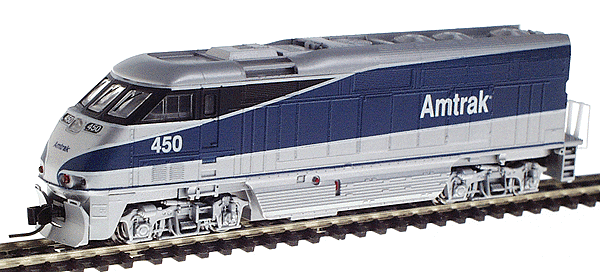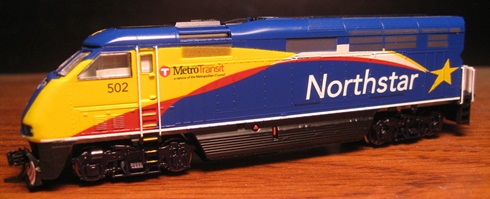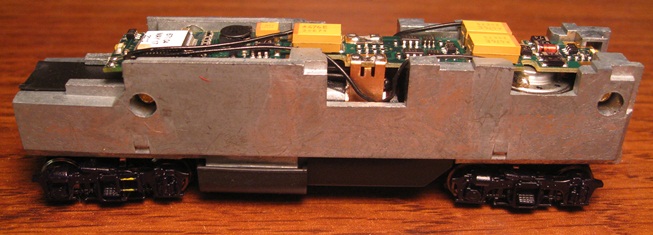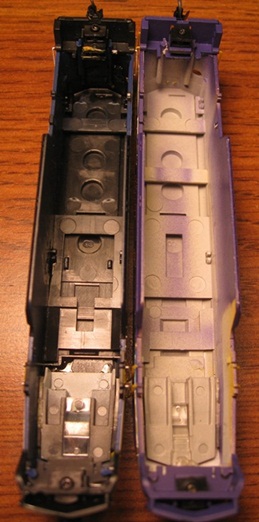

Introduced: 2002 (Korean-manfactured version) and 2011 (Chinese-manufactured DCC-version)
As noted above, there have been two distinctly different versions of this model - one made in Korea by Ajin and the other made in China by, well... whomever. The shells between the two releases are basically the same, but the similarities pretty much end there (but more on all that in a moment).
Athearn's original 2002 F59PHI model was that firm's first N scale locomotive release. Unfortunately, it was not a particularly auspicious debut for that venerable company. First off, one must question their choice of prototype - kind of an odd duck, and one with (presumably) limited appeal. And although Athearn should get kudos for going with shell-mounted Micro-Trains couplers right from the get-go, their decision to originally make all the tiny little handgrabs a "do it yourself" project was probably a mistake.
Still, these were fine looking models with decent paint and detailing. Unfortunately, it's the mechanism where things start to go south. Quite frankly, this thing looks like something Roco might have designed back in the 1970s -

The first version chassis is a complex assembly, consisting of a big chunk of metal and a bunch interlocking plastic pieces. The motor is buried inside there someplace, and to get a look at it I'd need to completely disassemble the whole mechanism. However, I'm told that it's an open-frame / skew-wound 3-poler. All wheels provide pickup (no traction tires), with current transferred from wipers on the truck assemblies to long skinny metal contacts inside the chassis. Current is then routed to the motor and lightboard via a maze of metal contact strips running hither and yon throughout the chassis assembly. Bi-directional LED lighting is provided by the aforementioned lightboard (which is clipped to the top of the chassis). All wheels are geared and all gearing is plastic. The dual driveshafts are each equipped with a flywheel. The driveshafts connect to swiveling truck towers which house the worm gears. Said worm housings are actually part of the truck assemblies themselves (as opposed to the chassis). Wheels are blackened and low-profile (no problems on Code-55 rails).
Performance on this first version is quite good (for the most part). Throttle response is smooth and pickup is fine. Slow speed creep is respectable. The chassis is quite hefty, so pulling power is strong. Unfortunately, the top-end speed is really excessive. In fact, these are probably the fastest runnings locos I've ever seen. The main problem with these models though, is that they are very noisy. Another disappointment is that, apart from the motor being electrically isolated from the chassis, there is no specific support for DCC.
As mentioned above, the handgrabs were originally supplied ala carte. And if you want to put them on, you're on your own - there are no instructions. I eventually figured out that two long grabs go on either side of the ladders that go up to the cab doors, and one short grab goes on each side at the back. They press-fit in place, although I had to stick a needle in the tiny little holes to clear out enough room for mine to fit (which unfortunately wound up chipping the paint). So no, not an entirely painless procedure, but I guess I've seen worse. An extra grab of each size is provided in case you screw up or lose one.

So overall, not a bad locomotive at all. But given the handgrab situation, the noise factor and the lack of DCC support, I can't quite give this first version an "A" rating.
As mentioned above, the second version (released in 2011) is quite different from the first. The basic shells are pretty much the same between the two (at least externally). However, the good news is that all the handgrabs come preinstalled -

Internally, the chassis/mechanism is all new (designed along the same lines as Athearn's Chinese-manufactured F45 and FP45 models) -

All of the modern mechanical niceties are here - split-frame / all-metal DCC-Ready chassis, dual flywheels, low-friction drive, bi-directional LED lighting, all-wheel pickup and drive (no traction tires), all-plastic gearing, blackened / low-profile wheels, shell-mounted McHenry couplers, etc. Better still, these models are available with factory-installed DCC-sound decoders (and presumably the same decoders used in the aforementioned F45 and FP45 models).
Performance on this new version is outstanding in every way. Smooth, quiet, and responsive. Excellent slow-speed creep and (thankfully) a very reasonable top-end speed. Pickup is great, so no problems stalling through turnouts with non-powered frogs. Better still, no problems with the decoder sound cutting out and restarting (an annoyance I've encountered with other sound-equipped diesels). Pulling power is excellent, as mine can easily haul five Bombardier cars up a curving grade (made even more impressive by the fact that said Bombardier cars are not particularly free-rolling). Overall, just a terrific locomotive model - and one that runs every bit as good as it looks.

One note about shell-swapping. The interior configuration of the shells between the two versions is not identical (what with the interior of the new version's shell having been changed around in order to accommodate the new chassis). And although putting a first-version shell on a second-version chassis looks do-able, the shell would need to be modified first (particularly up around the cab).

It should be noted that a lot of Athearn's F59 paint schemes are fantasies (my Minnesota Northstar F59 being an apt example). Many of the roads Athearn has selected actually run/ran MP36's and MP40's - similar to the F59, but obviously not the same. Still, the Athearn models are decent enough stand-ins, at least until such time as somebody (IE, Kato) comes out with similarly painted MP36 models.
Features (second version) -
- Era: Late 1990s to now
- All-wheel drive and electrical pick-up
- 5-pole skewed armature motor
- Machined brass flywheels
- Available as DCC WITH SOUND
- Upgraded drive train - slower speeds than prior runs
- Available DCC-ready without sound
- Celcon handrails
- McHenry knuckle spring couplers
- Sound units are equipped with Tsunami Sound from SoundTraxx
To remove the shell (either version), insert a couple of small screwdrivers (or toothpicks, or whatever) between the shell and the chassis and spread the sides of the shell apart. The shell should lift off readily at that point.
Grades: B (first version) and A (second version)
First version reviewed: 04/03 Model Railroader ("Athearn has kicked off its N scale locomotive line with a good-looking model of an Electro-Motive F59PHI passenger diesel. It combines an excellent body shell with a metal chassis that seems like it's a holdover from an earlier generation and capable of producing some amazing speeds... The model closely follows prototype drawings... Athearn's F59 has an injection-molded styrene shell with most details cast in place, including fans, horns, grills, rear and roof grab irons, a plow, and rear platform stanchions and handrails. The body detail is nicely done. Clear styrene is used for window glazing (with wipers molded in place), headlights, and ditch light lenses. Red-tinted clear styrene is used for the front marker lights. A plastic piece inside the cab provides a rudimentary cab interior, mainly serving to block the chassis from view through the windshield. The truck sideframes are plastic and snap into place on the trucks... detailing on the sideframes is quite shallow...
"The single-piece die-cast chassis doesn't carry electricity - power is transmitted by phosphor bronze strips that run the length of each side and contact wipers above each truck sideframe. A plastic motor mount holds two contacts that carry power from the long strips to the motor. An open-frame motor drives both trucks via standard U-joints. Brass flywheels are mounted on the drive shaft at each end of the motor. Brass worms atop each truck tower in turn power all axles via plastic gears. The circuit board atop the frame holds a pair of yellow LEDs that illuminate the headlight and rear light - a strange choice considering the current availability of bright white LEDs. The model runs like a jack rabbit, topping 100 scale mph around 4.5 volts. Although the model will run at a scale 4.8 mph, it's quite jerky at that speed, but it smooths out at about 12 mph... The model runs smoothly at normal operating speeds, but you'll be using only a small portion of your throttle range... No provision is made for DCC, but the motor is isolated from the frame... Micro-Trains couplers are factory-installed at the proper height... Paint coverage is good, separation lines are sharp, and the letting is clear and legible. The printed number boards are a nice touch. Athearn's F59PHI is a good model of a modern passenger diesel, but I hope future models offer much more in the way of speed control. Amtrak, Metrolink, Sounder, Coaster, West Coast Express, Dallas Trinity $89.98")